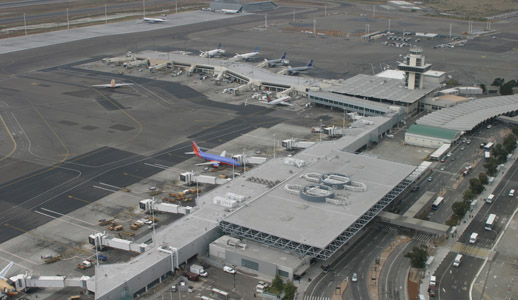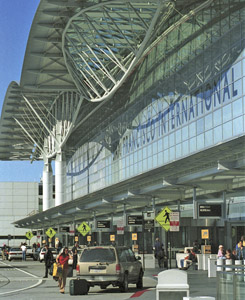Forecasting the number of passengers at Bay Area airports to soar to 101.3 million in 2035 from 58.4 million last year and 60.6 million in the pre-recession year of 2007, a new report by the Regional Airport Planning Committee (RAPC) recommends a range of strategies to meet the Bay Area’s future airline passenger and air cargo needs.

Mineta San Jose International Airport (pictured) and Oakland International Airport have ample runway capacity and terminal facilities to accommodate more flights. Photo courtesy of MTC
By John Goodwin
Published: June, 2012
Forecasting the number of passengers at Bay Area airports to soar to 101.3 million in 2035 from 58.4 million last year and 60.6 million in the pre-recession year of 2007, a new report by the Regional Airport Planning Committee (RAPC) recommends a range of strategies to meet the Bay Area’s future airline passenger and air cargo needs.
To provide maximum benefit to air travelers and the regional economy while minimizing adverse environmental consequences, RAPC’s "Regional Aviation Activity Tracking Report" specifically recommends:
• encouraging airlines to add more flights at the Oakland and San Jose airports, thus shifting more air passengers to these facilities in the years ahead;
• encouraging airlines to provide more service at the Charles M. Schulz-Sonoma County Airport to accommodate the needs of North Bay air passengers;
• supporting further airline service expansion at airports outside the Bay Area, such as Sacramento, Stockton and Monterey, to make these facilities more attractive to passengers who currently use Bay Area airports;
• implementing key elements of the Federal Aviation Administration’s NextGen air traffic system to enable more efficient airspace and runway operations;
• implementing new demand management approaches at SFO to better match airline fleets and schedules with the airport’s runway capacity; and
• using high-speed rail to meet a portion of the travel demand among passengers traveling between the Bay Area and other parts of California.
The new tracking report, which updates the "Regional Airport System Analysis" report released by RAPC last fall, notes that despite a nearly 16 percent increase in the number of passengers using SFO from 2007 to 2011, the total number of passengers using the region’s three major airports—which also include Oakland International (OAK) and Mineta San Jose International (SJC)—fell 3.6 percent during this period.
RAPC expects continued growth in passenger volume at SFO to put increasingly greater pressure on runway capacity at the Bay Area’s busiest airport. Flight delay problems at SFO already are common during poor weather due to the close spacing of the airport’s two main landing runways. Because one way for airports to handle more passengers with existing runways is for airlines to use bigger planes that can carry more passengers per flight, a positive trend at SFO is an increase in the average number of passengers per flight to 118.6 last year from 115.6 in 2007.
RAPC’s long-range forecasts indicate a gradual continuation of this trend, driven by a growing market for long-distance international travel that requires larger wide-body aircraft. However, because SFO is a connecting hub for United Airlines, it will continue to serve large numbers of regional jets and turboprops, which are more economical for feeder service from outlying communities.
"Part of RAPC’s long-range strategy," explained Doug Kimsey, planning director for the Metropolitan Transportation Commission (MTC), "is to relieve pressure on SFO’s runways by expanding the use of the Oakland and San Jose airports. Both airports have the terminal facilities and runway capacity to accommodate more flights. But since it’s the airlines who decide where they want to add service, it’s hard to look 20 or 25 years into the future and forecast precisely how many passengers will use each Bay Area airport."
"We expect Bay Area airports to be able to serve the projected 2035 travel demand without high-speed rail," Kimsey continued. "But high-speed rail would relieve pressure on airport runways to handle growing demand while providing additional environmental benefits for the region."
RAPC includes representatives from the Bay Area’s three major airports, the Association of Bay Area Governments and the Bay Conservation and Development Commission as well as MTC. The complete Regional Aviation Activity Tracking Report can be reviewed online at www.mtc.ca.gov/planning/air_plan/Airport_Tracking_Report.pdf.

Oakland International Airport ranks number one among all Bay Area airports for air cargo volume and number two for airline passenger activity. Photo courtesy of MTC

San Francisco International Airport accounts for nearly 97 percent of the Bay Area’s international airline passenger traffic. Photo courtesy of MTC

